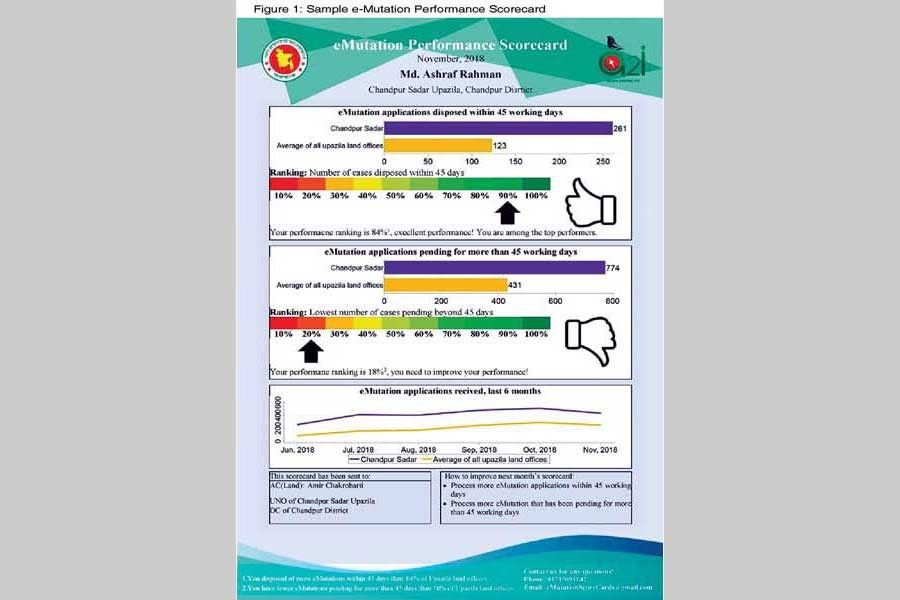Using transformative potential of technology to ensure sustainable improvements in public service delivery for citizens is a crucial pathway to realise aspirations of 'Digital Bangladesh'. Technological innovation in this area opens the window of opportunity to simultaneously monitor and incentivise performance of public service providers, maximising benefits of such innovations.
Land-related services have been notorious for their age-old, complicated bureaucratic processes, further bogged down by a medley of middlemen. The government has brought land mutation services under electronic or 'e' platform coupled with process simplification for faster service delivery. Whenever ownership of land changes, either through sale or inheritance, the new land 'record of rights' must be issued. These land record changes, commonly known as mutations, are conducted by civil servants holding positions called Assistant Commissioner (Land) or AC Land.
AC Land offices are asked to dispose a mutation application within 45 working days but in practice delays beyond this time limit are common. Previous research by Copenhagen Consensus and BRAC Institute of Governance and Development (BIGD), BRAC University, found limited positive return from e-mutation investment. This was because of the low outreach of e-mutation.
However, currently e-mutation process has been rolled out to almost all Upazila Land Offices that are using the system to some extent. How can e-mutation be put to its best use?
We know that better incentive structures for civil servants improve public service delivery. The e-governance system and the time-bound public commitment of service provides a unique opportunity where we can rigorously test if simple management tools like motivation and monitoring can incentivise performance.
The International Growth Centre (IGC) co-funded a research study, led by Martin Mattsson, researcher at Yale University, USA, where administrative data from the e-governance system is used to provide a monthly performance scorecard for AC Land officers who are in charge of the upazila land offices. The study was conducted over 12 months (September 2018-August 2019) and utilised a randomised control trial methodology to measure impact of performance scorecard. Initially the study included 112 land offices which was later expanded to over 300 land offices.
The monthly scorecard highlights the number of applications that were processed within 45 working days and the number applications that are pending (beyond 45 working days). Performance scorecard provides information on how better or worse it has done compared to other land offices. The monthly scorecard is sent to the AC Land, his/her direct superior, the Upazila Nirbahi Officer, and his/her superior's superior, the Deputy Commissioner of the district. The scorecards thereby work both as a monitoring as well as a feedback mechanism. (See Figure I)
The results show that scorecards increased timely disposal of application by 9.0 percentage points or 22 per cent. The scorecards also decreased the processing time by approximately 24 per cent, the median processing time fell from 53 to 45 days. There are savings in terms of the number of visits to the Upazila Land office and Union Parishad Land office. These visits decreased by 0.9 visits per application or approximately 10 per cent.
A common challenge faced by senior civil servants is lack of relevant information to systematically evaluate performance of junior civil servants. This research provides a strong evidence for effectiveness of the scorecard; it augments monitoring and evaluation through a continuous feedback system, which in turn provides motivation and creates a dose of healthy competition among peers even in absence of an explicit incentive.
The research also highlights another important issue -- a more potent and pragmatic method for improving bureaucratic efficiency needs to incorporate a dual approach where good performance is rewarded and weak performers are provided tools and resources like guidance, mentorship, etc. from seniors to improve.
A quick and cost-effective scaling up of this intervention and its rigorous evaluation was possible due to digitisation. As more and more public services use e-governance systems, the Bangladesh government will have a wealth of up-to-date administrative data at its disposal; innovative ideas can now be tested using administrative data to check its effectiveness as a solution.
As with all organisations, one of the key assets is its human resources. The Bangladesh civil service is no exception and it comprises of some of our best and brightest citizens. It is essential that these promising civil servants are nurtured within a system that motivates them to excel, recognises their invaluable contribution and rewards them.Going forward, 'data access and availability' can foster closer and more meaningful collaboration between government and researchers in co-generating innovative ideas, testing them and ultimately
calibrating policies based on research evidence.
Farria Naeem is Country Economist at the International Growth Centre (IGC). IGC, funded by UK's Department for International Development (DfID) and based in London School of Economics (LSE), is a global network of researchers and in-country teams working for promoting sustainable growth in developing countries.


